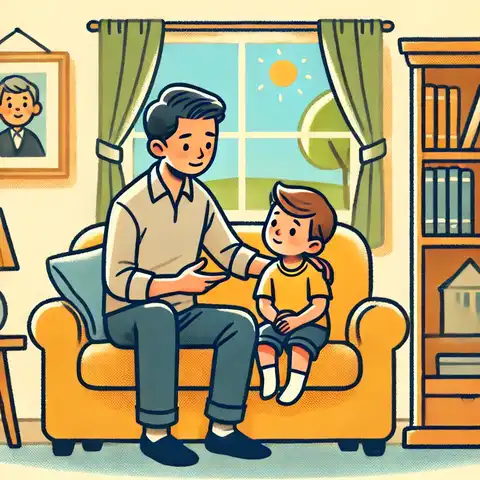Change is natural, and children struggle with it! Transitioning to a new school, moving in or out of one house and having a brother/sister/half-brother/baby sister of their own are some of the changes that any child goes through.
As a parent, the biggest thing you need to do is help your child with all this. That way, you can support how they feel, which will help them become more resilient.
In this post, we want to share some easy tips that you can give your child to help them be more resilient during rapid changes.
What Kids See When We Change
Change is seen very differently by children than by adults. For them, every little change can seem like a monumental one, as they may have no idea what’s going on.
Children crave continuity, so if doing things the same way always guarantees that everyone is at their calmest a morning, then why wouldn’t they feel comfortable starting every day off consistently?
Parenting Tips to Help Cope with Change
Here are some parenting tips for coping with change:
Keep Communication Open

Being honest is one of the primary keys to helping your child adapt to change. Tell the truth, even if it is hard to understand. Ex., explain why, what it will look like… You are moving to a new home.
At the end of a long day, I am exhausted because all I do is TALKANSWERTELL. Communication and LISTENING do things—it lets my staff talk—and it allows me to listen!
Recognize your child’s worries or fears. Reassure them that it’s okay to be sad, frightened or anxious. Children need to be able to say what they are going through and feel that if adults understand them, they can speak of their emotions.
Prepare for The Shift with Each Other

Preparing together for a change can be critical to how your child will process it. Wherever possible, get them involved in the planning process.
If you are moving, for instance, have them help with packing up their things or choosing how they want to decorate your new room.
If there is a new sibling on the way, get them involved in preparing the nursery or choosing baby clothes.
Keep Routines Steady

Routines that never change make a child feel safe even when everything else is changing.
Stick to regular schedules. The more familiar kids are with their day-to-day routines, the less affected everyday life will be. Also, regular routines can be comforting when everything else in your life is changing.
It is also okay to help your child ease into the transition by starting new routines or traditions.
For instance, if you moved to another community and the area is rich in parks, a new tradition may be simply living beside a different park or doing all of them every weekend (One For Each Day).
Let Them Express Themselves

It is essential to give your child an opportunity for self-expression in moments of change. Reassure them that it is understandable not to make complete sense of the current world.
Up the street, you need to exhibit healthy emotional expression, too, by acknowledging when you are feeling feelings so that they can learn from your feedback.
You might say something like, “I feel nervous about moving, too, but I bet we will meet new friends and have fun adventures.” Your child can see that it is okay to be mixed about change.
Develop perseverance and creativity in problem-solving

Stress and the ability to bounce back: Human beings are adaptable, but there is a sweet spot.
Coping with change plays a vital role in resilience. To all the parents out there, help your children develop resilience by enabling them to solve problems.
Sure, in the beginning, things could be solved quickly and effortlessly; however, no one is born knowing how to think critically about an issue, so it must arise as a muscle would.
Encourage them to take time to think about fixing up what they can or whichever way suits them best before even starting anything else (and practice this if they believe they are like you), and praise them for trying without fail; their solutions may not work, but who says we are dead correct in our lives?
You are also doing them a favor by being an example of how to build resilience. Demonstrate to your child that disappointing things can happen, and it’s still okay.
For instance, you could say something like, “I’m sorry we can’t go anywhere today, but maybe there’s an activity at home that will help us have some fun.”
Ensure it Is a Judgment-free Zone.
Change can often bring up multiple questions for kids. Develop a supportive atmosphere, one in which even the most minor questions need to be entertained. Respond to their questions factually age-appropriately
Children may even ask the same question five times over as they try to grapple with something they cannot understand.
His directions would be equally simple: Answer with patience and answer consistently. Repetition can feel solid to them as they work through their emotions and ideas.
Use Positive Reinforcement
Encouragement and positive reinforcement can be great tools for helping kids with change.
Celebrate when your child manages a shift with little or no difficulty or any new challenge that they are able to face head-on.
For instance, if your child works to meet new friends in a new school, you can praise them for their courage and sociability.
Provide additional comfort and reassurance.
Children may need extra comfort and reassurance during times of change. Offer more extra hugs, cuddles, and one-on-one time.
Reminders of constancy — that which will be as it always has been. Let your child know what will be the same, for example — you love them and family traditions or routines. It will help you feel a sense of continuity with all those changes.
Skills to Foster: The Mindfulness And Relaxation Edition
They teach mindfulness and relaxation techniques to help them cope with moments of anxiety, stress, or worry about change.
Accessible beginner practices such as deep breathing, visualization, and progressive muscle relaxation work wonders for calming the nerves.
Help your child learn to breathe slowly and deeply when they are feeling overwhelmed, or have them imagine a place where they feel safe & happy.
Encourage Social Connections
A social system is critical to young children during challenging periods of change, as it helps them stay in touch with friends and family who are far away.
Schedule play dates, facetime or family visits to keep those bonds.
Help your child meet and make new friends if they are going to a different school or area.
Set Realistic Expectations
It is essential to have realistic expectations about your child’s ability to handle change.
Realize that it takes time for them to adapt, and there will be good days and bad. Just be patient and allow them to process their feelings.
Just know that you dont need to have all the answers, and it is OK to ask for help when needed.
Use Stories and Books
Pick out books that relate to the type of change your child will be experiencing, such as a move or transitioning into preschool.
Reading together can solve the problem of comforting them and allow us to discuss how they feel.
Patience And Adaptation
It is essential to allow time for adjustment, especially with children. Give them the time to feel how they want in their way. Be prepared for any backward steps or resistance, and that is perfectly fine.
Super Mom: Watch Your Chidings Activity
Notice the ways your child may be exhibiting behaviors that signal that they are having a hard time adjusting.
These behaviors may include no longer sleeping or eating well, mood swings or withdrawal from things they once loved.
When you see something that raises a red flag, instead of tackling the issue with anger and negativity, try to find more empathy for your child! Share with them that it is normal and the way they feel; you will help to find a solution.
Foster Problem-Solving and Analytical Thinking
Children who have problem-solving and critical thinking skills are better equipped to handle change because they feel less out of control.
If your child is anxious about starting a new school, discuss possible ways of making friends or techniques for learning to navigate the building (e.g., locker locations). ·
Aspects for Reminding Yourself of Change
So long as I know what to expect, life is easier for me. It might be boring in its predictability sometimes, but change, even when it begins to be painful, is one of my favorite things.
Help your child see change in a positive light by highlighting its fun or adventure. Talk about exciting things like all the new places you’ll get to adventure together if there’s a move coming up.
It helps teach your child to look on the bright side, which will make them a lot happier and help them feel more prepared for what´s going on.
Allowing Your Child to Be a Part of the Decision-Making Process
Whenever possible, allow your child to be part of the process of making decisions about change.
This gives them a sense of control over the situation. For instance, when moving to a new place, allow them to pick the painting color in their new room or put their toys where they want them.
Children feel included and less scared when they have a say in decision-making.
Be Positive and Supportive
What you think and do can impact how well your child deals with changes. Be uplifting and encouraging, even if you feel worried or stressed.
Your child looks up to you for how they should respond, and staying calm and confident is essential.
The lower your stress, the better support system you can be for them; The more you take care of yourself, the better everyone in your family feels.
Teach Healthy Ways to Cope
Assist your child to manage the stress and worry of changes better. Article 6: Encourage Relaxation Activities like playing outside, drawing, and other things they enjoy can help them relax.
Show them that, yes, it is OK to stand down and look after yourself when life gets heavy. These good habits will help them become attuned to managing changes.
Seek professional assistance if necessary.
If your child is struggling with change and you are concerned about their emotional well-being, talking to somebody may be helpful.
If needed, do not hesitate to ask for help. Sometimes, your kiddo really just needs to talk it out with someone other than you. Working with a pro can offer your child coping mechanisms to help them navigate their emotions.
Conclusion
Change is an inevitable part of life, and it can be traumatizing to deal with—especially for kids. Indeed, as a parent, it is your role to enable and encourage your child to see that change can be turned into power sometimes.
This way, you are there for them and can teach your child mental strength so they feel strong and empowered.
Always remember that each child is different; what works for one may not work for another.
Have patience, be positive and never shy away from asking for help. This kind of support can help the child learn how to deal with transitions and change.


